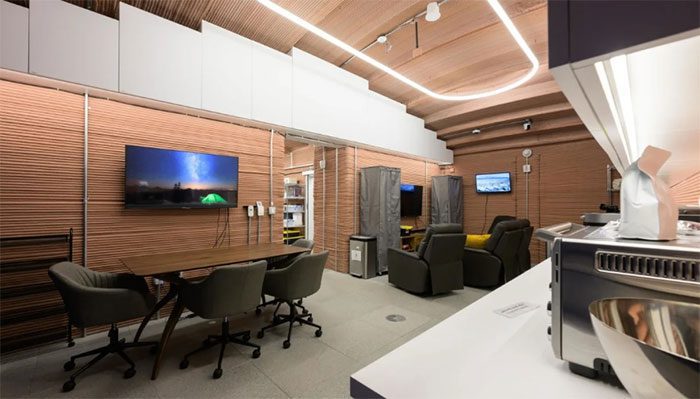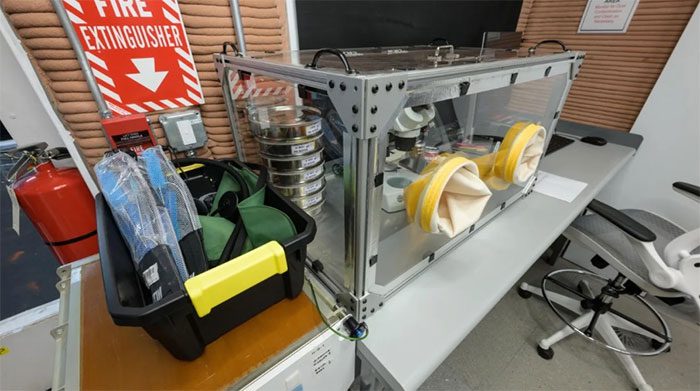The journey to conquer Mars has always been a long and perilous one. A challenge that scientists face today on this journey is how to ensure long-term human life on the harsh environment of the “Red Planet” once we set foot on its surface.

The kitchen and living area of the CHAPEA crew. Four participants will spend 378 days inside a base covering 157m2. (Photo: NASA).
To prepare astronauts for extended stays on Mars, the United States National Aeronautics and Space Administration (NASA) has recently launched a simulation mission called CHAPEA (Crew Health and Performance Exploration). In this project, four researchers will be isolated and live entirely inside a simulated Martian environment in Texas for 378 days – nearly the amount of time astronauts will need to complete a mission on the surface of Mars.
After isolation, this research team will adhere to a pre-planned schedule, engage in simulated activities and scientific work, eat and drink like astronauts, handle maintenance issues and equipment malfunctions, and undergo rigorous psychological and physiological testing.
The first simulation round will begin in June, with NASA planning to conduct two additional simulation rounds. Each round will involve a different group of participants, but living conditions will remain the same.
Scott M. Smith, co-investigator of CHAPEA, detailed: “We have developed a highly accurate mission scenario for the surface of Mars. Participants will experience a 22-minute communication delay with the outside world, similar to what astronauts will face on Mars. Ambient noise will be played through speakers to ensure that those living in this simulated environment cannot hear sounds from outside.”
The simulated environment that scientists will experience is called Mars Dune Alpha. This is a custom design by the Bjarke Ingels Group and the 3D printing company ICON, located within a hangar at the Johnson Space Center in Houston, Texas. The architecture was completed through 3D printing in just one month, based on the idea of utilizing Martian soil. ICON’s CEO Jason Ballard explained: “NASA has considered many options for building a living environment on Mars.”
The Mars simulation space includes a working area, living area, kitchen, private bedrooms, bathrooms, a medical area, a communication center, a gym, ventilation systems, and an “outdoor” area simulating the Martian surface. According to expert Smith, the separation of living and working areas is intentional.

Experimental equipment inside the CHAPEA living environment. The crew will conduct simulated scientific work. (Photo: NASA).
Over the course of 12 months, four NASA researchers and engineers, including Kelly Haston, Ross Brockwell, Nathan Jones, and Alyssa Shannon, will work and live in the 157m2 space.
A NASA representative stated that the agency is seeking to fill a “strategic knowledge gap” that previously made sending humans to Mars and conducting missions there too risky.
According to Smith, there are currently four risks that humans face when conducting missions on Mars, including radiation; SANS (Spaceflight Associated Neuro-Ocular Syndrome, which affects a majority of astronauts during prolonged exposure to microgravity); crew behavior and performance; and food and nutrition.
While a simulation environment cannot realistically test the effects of radiation and microgravity on humans like actual Martian conditions, the main goal of CHAPEA is to assess human health and performance.
“If you look back at historical accounts, food and nutrition either make or break many exploratory journeys. When at sea or in the Arctic or Antarctic, if you don’t plan your nutrition well, things won’t go smoothly,” Smith stated.
The journey to Mars is estimated to take between 6 to 9 months. The crewed mission to Mars will be responsible for transporting food to the planet before humans arrive. This means that the food will need to have a long shelf life.
Expert Smith explained: “Food will be consumed within about 5 years after we produce it. If you think about filling your pantry with food to sustain you for the next 5 years, that’s truly a challenge.”
Within the simulated living environment, the four researchers will eat similar rations to those on the International Space Station (ISS). Participants will also grow vegetables using hydroponic systems to help stabilize their mental health and ensure nutritional adequacy.
They will also undergo blood, urine, saliva, and stool testing, monitor behavior, and measure physical performance. Body mass and composition, nutritional status, immune function, cognition, and microbiome will all be evaluated. “Basically, we’re looking at all physiological factors,” Smith said.
Even after the simulation period concludes, participants will undergo several weeks of medical examinations at the Johnson Space Center.
Smith added: “A certain level of commitment is required to be ready to spend a year with us. Not everyone is suited for this mission.”
Across the globe, similar separate projects are also underway, and NASA as well as other space agencies are striving to build a comprehensive knowledge base with hopes of encompassing the entire Mars mission.

Graphic design of the Mars Science City in Dubai.
Specifically, in the United Arab Emirates (UAE), the government is implementing the construction of a Mars Science City covering 176,000m2 and costing $136 million in the desert outside Dubai. Previously, the Russian Research Institute collaborated with NASA on SIRIUS – International Scientific Research at the only ground station, a isolation program in Moscow. Meanwhile, the Human Exploration Research Program HERA has conducted 6 isolation missions within a 60m2 simulated space model.




















































